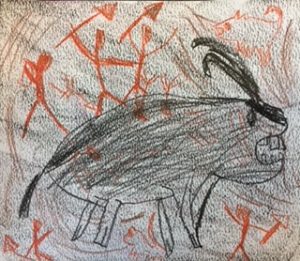Our travels through time have begun. With a focus on transport through the ages, Year 4 started off their journey learning about chronological order. The children put together a time line of events through history.
Following this, we studied early humans and how artefacts found have given us clues as to how these people lived. This initiated a conversation as to how history has shaped the lives we lead today.
Year 4 confidently carried out some research into cave paintings. I was very impressed by some of the children’s prior knowledge.
“Blood was used to add detail and colour. Bones were hollowed out so ‘paint’ could be blown through them onto the walls,” commented Albie.
“They had to use their legs as transport and the animals carried heavy items,” stated Jessica.
Did you know?
Four boys searching for a lost dog discovered paintings at Lascaux, France in 1940. These paintings were created around 15,000 BC, which would make them about 17,000 years old.
What did the paintings mean?
We discussed reasons as to why cave paintings were created.
There are three theories that the prehistoric man might have painted animals on the walls of the caves.
- The cave man wanted to decorate the cave and chose animals because they were important to their existence.
- The second theory could have been that they considered this magic to help the hunters.
- Prehistoric man could have used the painting of animals on the walls of caves to document their hunting expeditions.
Methods of Painting
Prehistoric people would have used natural objects to paint the walls of the caves. To etch into the rock, they could have used sharp tools or a spear. The paint or color that they probably used was from berries, clay, soot, or charcoal. The tools used to apply the paint could have been made by attaching straw, leaves, moss, or hair to sticks. They might have used hollow bones or reeds to spray the color on, similar to an airbrush technique we use today.
When we had finished our research and discussion it was time to create our very own cave paintings. Using different media, the children selected appropriate resources to make their painting look as realistic as possible.

